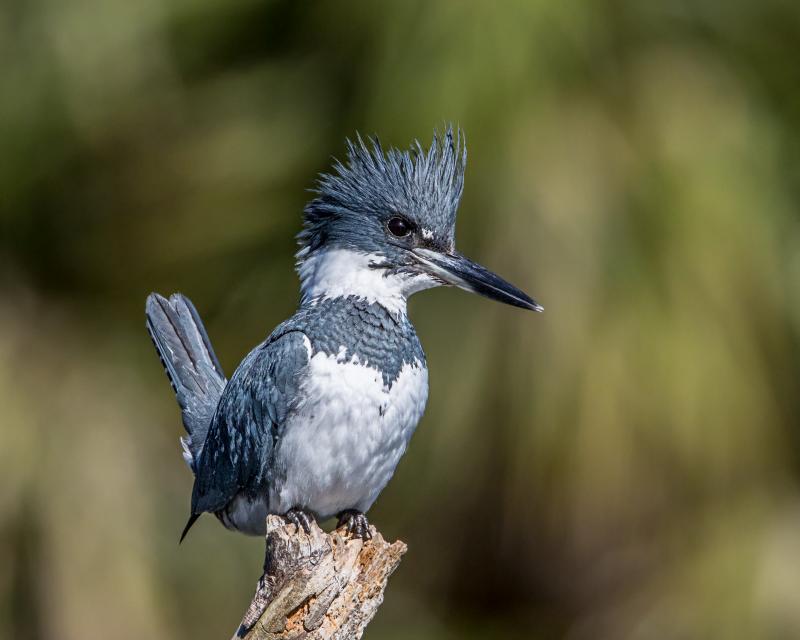Kevin’s Winter Kingfisher
Our illustrious editor, Kevin Burnham, emailed us last week to say that he had recently seen a big-billed, blue bird with a wild hairdo sitting on the Southport bridge. A first reaction might be that Kevin was hallucinating or remembering a bad COVID dream. Or that he must have just seen a wayward blue jay that happened to stop on its way across the inlet.
But Kevin is as careful an observer as he is an editor and it was soon confirmed that the bird Kevin had seen was none other than a belted kingfisher.
In spring, summer and fall, we all expect to see the bold blue and white belted kingfisher all along our coastal shores and inland along lakes, rivers, and streams. Sometimes we see it perched on the top of an old snag along the water’s edge. Sometimes it perches on a dock or piling from where it can fly out to hover over the water and plunge in to capture a small fish or invertebrate. We love to hear its harsh rattle echoing out over the water as it gives chase to another of its kind in territorial dispute.
In winter, most belted kingfishers head south. The largest wintering concentrations occur in the southeastern U.S. in states like Florida, and along the coasts of Louisiana and Texas. Some belted kingfishers go as far south as northern South America for the winter. We have seen them commonly in winter on the islands of Aruba, Bonaire, and Curaçao just off the coast of Venezuela.
But among the belted kingfisher stock are some that are very hardy. Every year a few spend the winter along Maine’s southern and central coast. In fact, some have wintered along the coast as far north as Newfoundland in the East and in the Aleutian Islands of Alaska in the West.
Kingfishers as a family are quite diverse globally. Many species do not dive into water like our belted kingfisher, and many occur in forests and other habitats not closely associated with water. Some species in the kingfisher family do not eat fish but consume insects, spiders, and scorpions. Some catch lizards and snakes and even occasional small mammals and birds. One species specializes in digging in the ground for earthworms!
Most species in the kingfisher family occur in warmer, tropical and subtropical climes. Our belted kingfisher is the exception; it has an extremely widespread winter distribution and the most northernly winter and summer distributions of any of the kingfishers. This would seem to be in part because of its ability to find small fish and aquatic invertebrates even in very cold places as long as there is relatively shallow, open water available.
As climate change brings about generally milder winters, we may expect to find more belted kingfishers spending winters in Maine. We hope that Kevin input his recent kingfisher sighting into eBird—if not, Kevin, it’s not too late! We hope that any of you that see one of these birds with the shaggy hairdo this winter will add yours as well. It’s only through our collective sharing of information on what we see that we can document the changes to our bird populations that can inform their conservation. It’s a great feeling, and…it’s fun!
Jeffrey V. Wells, Ph.D., is a Fellow of the Cornell Lab of Ornithology and Vice President of Boreal Conservation for National Audubon. Dr. Wells is one of the nation's leading bird experts and conservation biologists and author of the “Birder’s Conservation Handbook.” His grandfather, the late John Chase, was a columnist for the Boothbay Register for many years. Allison Childs Wells, formerly of the Cornell Lab of Ornithology, is a senior director at the Natural Resources Council of Maine, a nonprofit membership organization working statewide to protect the nature of Maine. Both are widely published natural history writers and are the authors of the popular books, “Maine’s Favorite Birds” (Tilbury House) and “Birds of Aruba, Bonaire, and Curaçao: A Site and Field Guide,” (Cornell University Press).
Event Date
Address
United States
























